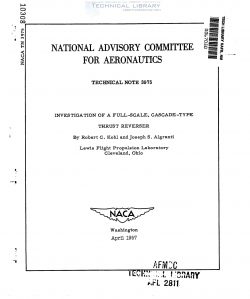naca-tn-3975
- Version
- 117 Downloads
- 2.44 MB File Size
- 1 File Count
- January 29, 2017 Create Date
- January 29, 2017 Last Updated
National Advisory Committee for Aeronautics, Technical Notes - Investigation of a Full Scale, Cascade Type Thrust Reverser

A cascade-type thrust reverser was installed in a single—engine,
fighter-type, turbojet airplane. A reverse-thrust ratio of about 55 per-
cent was obtained at full engine speed. Reverse-thrust ratios up to 56
percent were obtained by increasing the thrust-reverser inlet velocity.
Supplementary scale-model, unheated-air tests indicated a 5 percent
loss of forward thrust due to stowage of the turning vanes inside the
tailpipe. The effect of turning-vane Spacing on thrust—reverser perform-
ance and on tailpipe blockage was also determined by means of scale-model
tests.
Taxi tests on a dry asphalt-macadam runway indicated that the average
airplane deceleration was about 0.11 g‘s when using either wheel brakes
only or thrust reverser only. When the wheel brakes and thrust reverser
were used in combination, the awerage deceleration was doubled.
Reversing the jet thrust offers a means for decelerating turbojet-
powered aircraft. Many types of thrust reversers have been investigated
by testing scale models using unheated air, and several promising configu—
rations have been developed. However, some of the problems associated
with the installation and use of a thrust reverser can be studied only
in full scale.
The NACA Lewis laboratory has therefore conducted an investigation
of a full-scale jet—thrust reverser. The investigation was limited to
stationary and taxi tests. The airplane was not flown. The thrust-
reverser system was installed in a single—engine, fighter-type, turbojet
airplane, and consisted of a twin set of movable vanes stowed inside the
engine tailpipe upstream of the nozzle. The thrust-reverser installation
was designed to fit into the existing airplane with a minimum of struc-
tural modification or change of the fuselage contour. Reverse thrust was
produced by opening the tailpipe and moving the vanes outward to form
cascades that intercepted the rearward gas flow and turned it through
approximately 150°. Variation of the forward and reverse thrust with
engine speed was measured with the airplane held stationary. Taxi tests
were conducted on a dry aSphalt-macadam runway in order to provide data
with which to compare the distances required to bring the airplane to a
stop using (1) wheel brakes onhy, (2) reverse thrust only, and (5) a
combination of wheel brakes and reverse thrust.
| File | Action |
|---|---|
| naca-tn-3975 Investigation of a Full Scale, Cascade Type Thrust Reverser.pdf | Download |

Comment On This Post